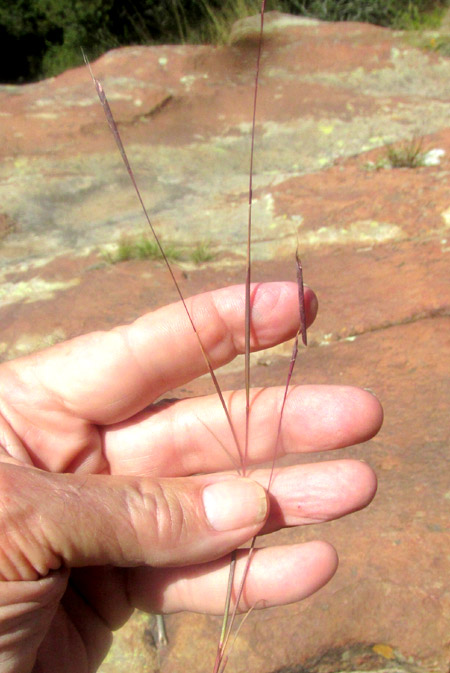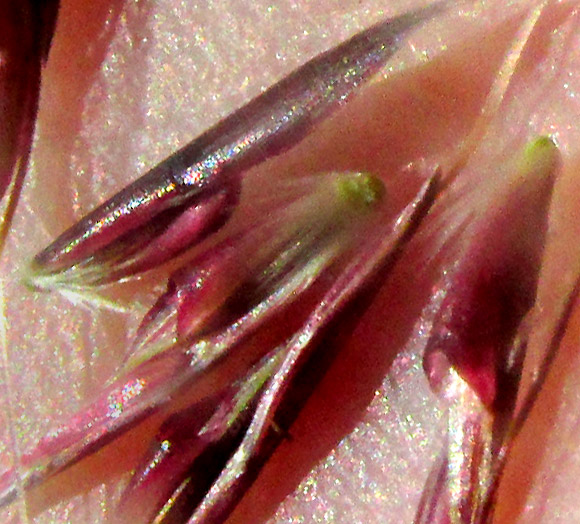Excerpts from Jim Conrad's
Naturalist Newsletter
Entry dated November 7, 2023, from notes taken at Cascadas de La Piedad waterfall 3kms NW of the community of San Pablo, municipality of Almeaco de Bonfil; bedrock of igneous andesite; N20.1008°, W100.0041°, elevation 2360 meters (7750ft); extreme southern Querétaro state, MÉXICO
CRIMSON BLUESTEM

Even during the ongoing two-year dry period classified by the "North American Drought Monitor" as an extreme D3 drought, a small stream of clear, cold water meandered across a livestock-grazed meadow atop a bed of pinkish, igneous andesite rock. Just before tumbling over a high ledge to create the picturesque Cascada de La Piedad, or Piety Waterfall, the above hip-high clumpgrass was flourishing, rooted in sediment accumulated beneath a boulder atop the sometimes-flooded andesite stream bed. In the above picture, notice how its extremely slender inflorescences were held together at stem tips, from a distance looking like a single slender structure.

Above, the various slender rames forming the slender flowering structure are forcefully separated. The term rame in botany refers to a long inflorescence, or flowering head, containing both stalked spikelets and spikelets attached directly to the rachis. For identification, it's important to notice that at the base of each of the above three rames, there's a small, slender leaf. This means that the whole flowering head consisting of three rames is not an inflorescence, but a collection of rame-type inflorescences. Most genera of the enormous Grass Family, the Poacae, don't produce rames, so noticing this feature considerably narrows down our grass's possible identities. In North America an important grass type producing rames is the bluestems, such as the Bushy Bluestem. That species produces several rames above each leaf, while our streamside plant developed only one above each leaf.

Above, a rame has been crumbled apart to show its constituent parts. Each unit is composed of two pressed-together spikelets, one spikelet stalked and the other not. Stalked spikelet bear at their tips long, needlelike, white awns, which also is a good field mark.

The spikelets are hairless, except for tufts of white hairs at their bases. A feature nicely shown above, at the picture's lower, right corner, is the hoodlike structure. That's a section of rame stem, described by the Flora of North America as being "cupulate," or cuplike, at its tip. Broken apart rame rachis sections with cupulate tips distinguish the genus of our grass from two other large rame-producing genera often known as bluestems: Andropogon and Bothriochloa. Our genus with cupulate rame rachis section tips is Schizachyrium.

At our grass's leaf bases where the blades meet their stems, short, collar-like, membranous ligules are produced. Right above the ligule the otherwise hairless blades are briefly covered with short, white hairs, and along blade base margins several long, stiff hairs occur.
The genus Schizachyrium currently comprises about 61 species occurring worldwide in tropical, subtropical and warmer parts of temperate zones. In upland central Mexico we appear to have three or four species, with our grass beside the boulder being the most commonly documented taxon. It's SCHIZACHYRIUM SANGUINEUM, often called Crimson Bluestem. Native to much of the warmer parts of the Americas, including the southernmost US, it also occurs in Africa and Asia, but the literature is unclear whether there it's also native.
One reason Crimson Bluestem is so widely distributed is that it's been spread around by humans because it provides good pasture for livestock when young. Also, it grows in a variety of habitats, from sandy soils and stony hillsides to the sides of rivers and streams. In some countries its long leaves provide thatching and matting. However, the species disappears when overgrazed, its seeds are sensitive to fire, and it gives way to competing invasive species.
Numerous publications mention that Crimson Bluestem is medicinal, but I find no mention of where it's used or for what ailments. However, in Daniel Moerman's 1998 Native American Ethnobotany it's stated that the Comanche burned the stems of Little Bluestem, Schizachyrium scoparium, for ashes to be used on syphilitic sores, so a good bet is that Crimson Bluestem may have been used for similar purposes here.